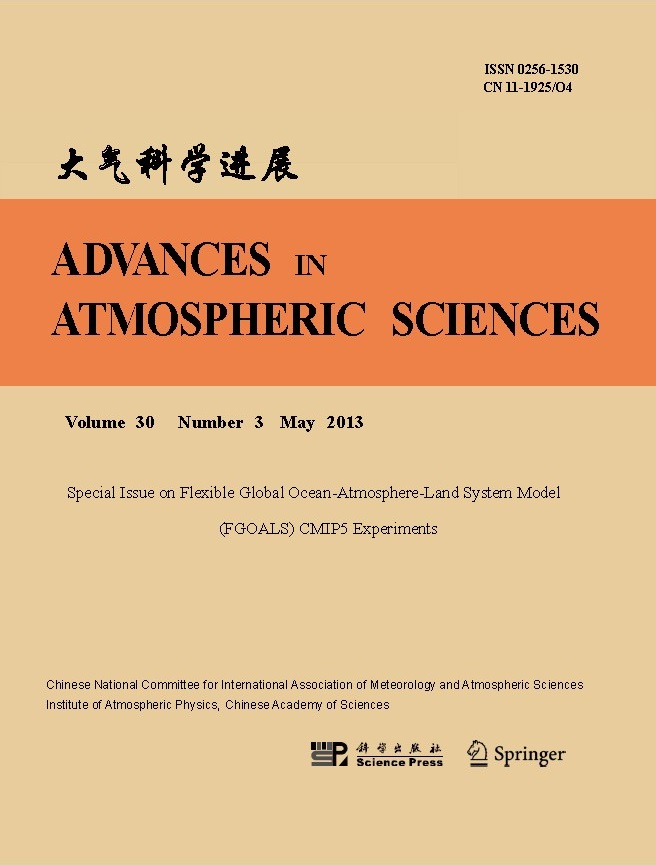| [1] |
Kaiqing YANG, Dabang JIANG,
2017: Interannual Climate Variability Change during the Medieval Climate Anomaly and Little Ice Age in PMIP3 Last Millennium Simulations, ADVANCES IN ATMOSPHERIC SCIENCES, 34, 497-508.
doi: 10.1007/s00376-016-6075-1
|
| [2] |
Weipeng ZHENG, Yongqiang YU, Yihua LUAN, Shuwen ZHAO, Bian HE, Li DONG, Mirong SONG, Pengfei LIN, Hailong LIU,
2020: CAS-FGOALS Datasets for the Two Interglacial Epochs of the Holocene and the Last Interglacial in PMIP4, ADVANCES IN ATMOSPHERIC SCIENCES, 37, 1034-1044.
doi: 10.1007/s00376-020-9290-8
|
| [3] |
Wang Huijun,
2000: The Seasonal Climate and Low Frequency Oscillation in the Simulated Mid-Holocene Megathermal Climate, ADVANCES IN ATMOSPHERIC SCIENCES, 17, 445-457.
doi: 10.1007/s00376-000-0035-4
|
| [4] |
Wang Huijun,
2002: The Mid-Holocene Climate Simulated by a Grid-Point AGCM Coupled with a Biome Model, ADVANCES IN ATMOSPHERIC SCIENCES, 19, 205-218.
doi: 10.1007/s00376-002-0017-9
|
| [5] |
WEI Jiangfeng, WANG Huijun,
2004: A Possible Role of Solar Radiation and Ocean in the Mid-Holocene East Asian Monsoon Climate, ADVANCES IN ATMOSPHERIC SCIENCES, 21, 1-12.
doi: 10.1007/BF02915675
|
| [6] |
YU Entao, WANG Tao, GAO Yongqi, and XIANG Weiling,
2014: Precipitation Pattern of the Mid-Holocene Simulated by a High-Resolution Regional Climate Model, ADVANCES IN ATMOSPHERIC SCIENCES, 31, 962-971.
doi: 10.1007/s00376-013-3178-9
|
| [7] |
JIN Liya, WANG Huijun, CHEN Fahu, JIANG Dabang,
2006: A Possible Impact of Cooling over the Tibetan Plateau on the Mid-Holocene East Asian Monsoon Climate, ADVANCES IN ATMOSPHERIC SCIENCES, 23, 543-550.
doi: 10.1007/s00376-006-0543-y
|
| [8] |
Pengfei LIN, Bowen ZHAO, Jilin WEI, Hailong LIU, Wenxia ZHANG, Xiaolong CHEN, Jie JIANG, Mengrong DING, Wenmin MAN, Jinrong JIANG, Xu ZHANG, Yuewen DING, Wenrong BAI, Chenyang JIN, Zipeng YU, Yiwen LI, Weipeng ZHENG, Tianjun ZHOU,
2022: The Super-large Ensemble Experiments of CAS FGOALS-g3, ADVANCES IN ATMOSPHERIC SCIENCES, 39, 1746-1765.
doi: 10.1007/s00376-022-1439-1
|
| [9] |
JIANG Dabang, YU Ge, ZHAO Ping, CHEN Xing, LIU Jian, LIU Xiaodong, WANG Shaowu, ZHANG Zhongshi, YU Yongqiang, LI Yuefeng, JIN Liya, XU Ying, JU Lixia, ZHOU Tianjun, YAN Xiaodong,
2015: Paleoclimate Modeling in China: A Review, ADVANCES IN ATMOSPHERIC SCIENCES, 32, 250-275.
doi: 10.1007/s00376-014-0002-0
|
| [10] |
Bian HE, Yimin LIU, Guoxiong WU, Qing BAO, Tianjun ZHOU, Xiaofei WU, Lei WANG, Jiandong LI, Xiaocong WANG, Jinxiao LI, Wenting HU, Xiaoqi ZHANG, Chen SHENG, Yiqiong TANG,
2020: CAS FGOALS-f3-L Model Datasets for CMIP6 GMMIP Tier-1 and Tier-3 Experiments, ADVANCES IN ATMOSPHERIC SCIENCES, 37, 18-28.
doi: 10.1007/s00376-019-9085-y
|
| [11] |
Ye PU, Hongbo LIU, Ruojing YAN, Hao YANG, Kun XIA, Yiyuan LI, Li DONG, Lijuan LI, He WANG, Yan NIE, Mirong SONG, Jinbo XIE, Shuwen ZHAO, Kangjun CHEN, Bin WANG, Jianghao LI, Ling ZUO,
2020: CAS FGOALS-g3 Model Datasets for the CMIP6 Scenario Model Intercomparison Project (ScenarioMIP), ADVANCES IN ATMOSPHERIC SCIENCES, 37, 1081-1092.
doi: 10.1007/s00376-020-2032-0
|
| [12] |
Yaqi WANG, Zipeng YU, Pengfei LIN, Hailong LIU, Jiangbo JIN, Lijuan LI, Yanli TANG, Li DONG, Kangjun CHEN, Yiwen LI, Qian YANG, Mengrong DING, Yao MENG, Bowen ZHAO, Jilin WEI, Jinfeng MA, Zhikuo SUN,
2020: FGOALS-g3 Model Datasets for CMIP6 Flux-Anomaly-Forced Model Intercomparison Project, ADVANCES IN ATMOSPHERIC SCIENCES, 37, 1093-1101.
doi: 10.1007/s00376-020-2045-8
|
| [13] |
Shuai HU, Bo WU, Yiming WANG, Tianjun ZHOU, Yongqiang YU, Bian HE, Pengfei LIN, Qing BAO, Hailong LIU, Kangjun CHEN, Shuwen ZHAO,
2023: CAS FGOALS-f3-L Model Datasets for CMIP6 DCPP Experiment, ADVANCES IN ATMOSPHERIC SCIENCES, 40, 1911-1922.
doi: 10.1007/s00376-023-2122-x
|
| [14] |
Bo AN, Yongqiang YU, Qing BAO, Bian HE, Jinxiao LI, Yihua LUAN, Kangjun CHEN, Weipeng ZHENG,
2022: CAS FGOALS-f3-H Dataset for the High-Resolution Model Intercomparison Project (HighResMIP) Tier 2, ADVANCES IN ATMOSPHERIC SCIENCES, 39, 1873-1884.
doi: 10.1007/s00376-022-2030-5
|
| [15] |
Yuyang GUO, Yongqiang YU, Pengfei LIN, Hailong LIU, Bian HE, Qing BAO, Bo AN, Shuwen ZHAO, Lijuan HUA,
2020: Simulation and Improvements of Oceanic Circulation and Sea Ice by the Coupled Climate System Model FGOALS-f3-L, ADVANCES IN ATMOSPHERIC SCIENCES, 37, 1133-1148.
doi: 10.1007/s00376-020-0006-x
|
| [16] |
Yuyang GUO, Yongqiang YU, Pengfei LIN, Hailong LIU, Bian HE, Qing BAO, Shuwen ZHAO, Xiaowei WANG,
2020: Overview of the CMIP6 Historical Experiment Datasets with the Climate System Model CAS FGOALS-f3-L, ADVANCES IN ATMOSPHERIC SCIENCES, 37, 1057-1066.
doi: 10.1007/s00376-020-2004-4
|
| [17] |
Bian HE, Qing BAO*, Xiaocong WANG, Linjiong ZHOU, Xiaofei WU, Yimin LIU, Guoxiong WU, Kangjun CHEN, Sicheng HE, Wenting HU, Jiandong LI, Jinxiao LI, Guokui NIAN, Lei WANG, Jing YANG, Minghua ZHANG, Xiaoqi ZHANG,
2019: CAS FGOALS-f3-L Model Datasets for CMIP6 Historical Atmospheric Model Intercomparison Project Simulation, ADVANCES IN ATMOSPHERIC SCIENCES, , 771-778.
doi: 10.1007/s00376-019-9027-8
|
| [18] |
Kai Chi WONG, Senfeng LIU, Andrew G. TURNER, Reinhard K. SCHIEMANN,
2018: Different Asian Monsoon Rainfall Responses to Idealized Orography Sensitivity Experiments in the HadGEM3-GA6 and FGOALS-FAMIL Global Climate Models, ADVANCES IN ATMOSPHERIC SCIENCES, 35, 1049-1062.
doi: 10.1007/s00376-018-7269-5
|
| [19] |
Bian HE, Xiaoqi ZHANG, Anmin DUAN, Qing BAO, Yimin LIU, Wenting HU, Jinxiao LI, Guoxiong WU,
2021: CAS FGOALS-f3-L Large-ensemble Simulations for the CMIP6 Polar Amplification Model Intercomparison Project, ADVANCES IN ATMOSPHERIC SCIENCES, 38, 1028-1049.
doi: 10.1007/s00376-021-0343-4
|
| [20] |
Min ZHAO, Tie DAI, Hao WANG, Qing BAO, Yimin LIU, Hua ZHANG, Guangyu SHI,
2022: Simulating Aerosol Optical Depth and Direct Radiative Effects over the Tibetan Plateau with a High-Resolution CAS FGOALS-f3 Model, ADVANCES IN ATMOSPHERIC SCIENCES, 39, 2137-2155.
doi: 10.1007/s00376-022-1424-8
|















 AAS Website
AAS Website 
 AAS WeChat
AAS WeChat 
 DownLoad:
DownLoad: